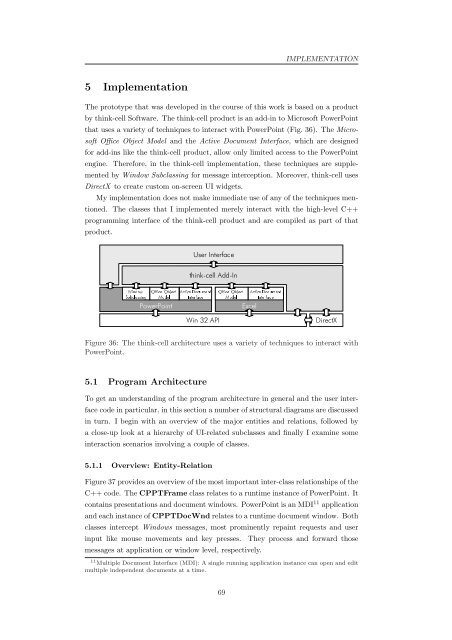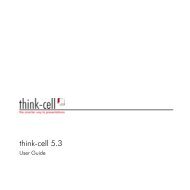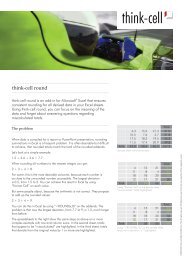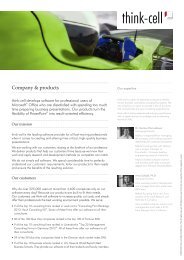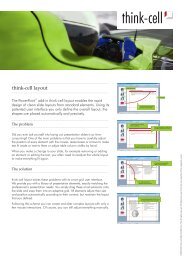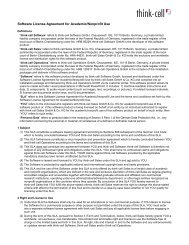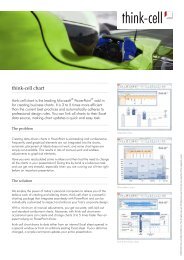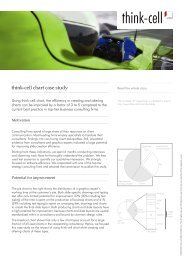think-cell technical report TC2003/01 A GUI-based Interaction ...
think-cell technical report TC2003/01 A GUI-based Interaction ...
think-cell technical report TC2003/01 A GUI-based Interaction ...
You also want an ePaper? Increase the reach of your titles
YUMPU automatically turns print PDFs into web optimized ePapers that Google loves.
5 Implementation<br />
IMPLEMENTATION<br />
The prototype that was developed in the course of this work is <strong>based</strong> on a product<br />
by <strong>think</strong>-<strong>cell</strong> Software. The <strong>think</strong>-<strong>cell</strong> product is an add-in to Microsoft PowerPoint<br />
that uses a variety of techniques to interact with PowerPoint (Fig. 36). The Micro-<br />
soft Office Object Model and the Active Document Interface, which are designed<br />
for add-ins like the <strong>think</strong>-<strong>cell</strong> product, allow only limited access to the PowerPoint<br />
engine. Therefore, in the <strong>think</strong>-<strong>cell</strong> implementation, these techniques are supple-<br />
mented by Window Subclassing for message interception. Moreover, <strong>think</strong>-<strong>cell</strong> uses<br />
DirectX to create custom on-screen UI widgets.<br />
My implementation does not make immediate use of any of the techniques men-<br />
tioned. The classes that I implemented merely interact with the high-level C++<br />
programming interface of the <strong>think</strong>-<strong>cell</strong> product and are compiled as part of that<br />
product.<br />
User Interface<br />
<strong>think</strong>-<strong>cell</strong> Add-In<br />
PowerPoint<br />
Excel<br />
Win 32 API<br />
DirectX<br />
Object Model Active Document Interface Active Document Interface Office Object Model SubclassingOffice Window<br />
Figure 36: The <strong>think</strong>-<strong>cell</strong> architecture uses a variety of techniques to interact with<br />
PowerPoint.<br />
5.1 Program Architecture<br />
To get an understanding of the program architecture in general and the user inter-<br />
face code in particular, in this section a number of structural diagrams are discussed<br />
in turn. I begin with an overview of the major entities and relations, followed by<br />
a close-up look at a hierarchy of UI-related subclasses and finally I examine some<br />
interaction scenarios involving a couple of classes.<br />
5.1.1 Overview: Entity-Relation<br />
Figure 37 provides an overview of the most important inter-class relationships of the<br />
C++ code. The CPPTFrame class relates to a runtime instance of PowerPoint. It<br />
contains presentations and document windows. PowerPoint is an MDI 11 application<br />
and each instance of CPPTDocWnd relates to a runtime document window. Both<br />
classes intercept Windows messages, most prominently repaint requests and user<br />
input like mouse movements and key presses. They process and forward those<br />
messages at application or window level, respectively.<br />
11 Multiple Document Interface (MDI): A single running application instance can open and edit<br />
multiple independent documents at a time.<br />
69


